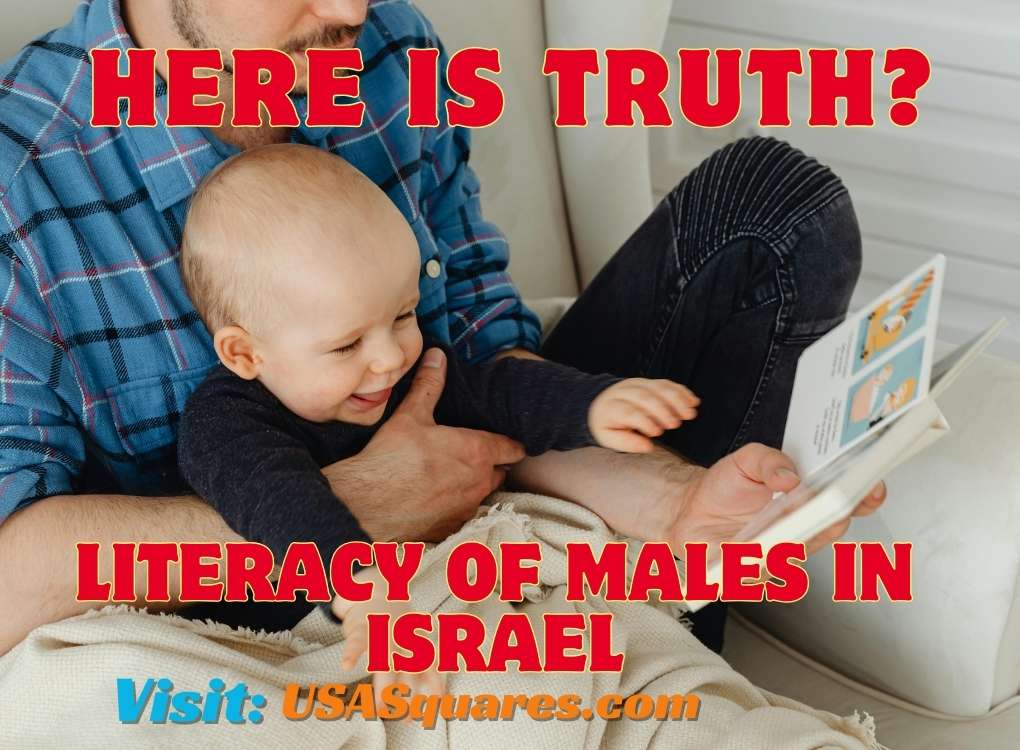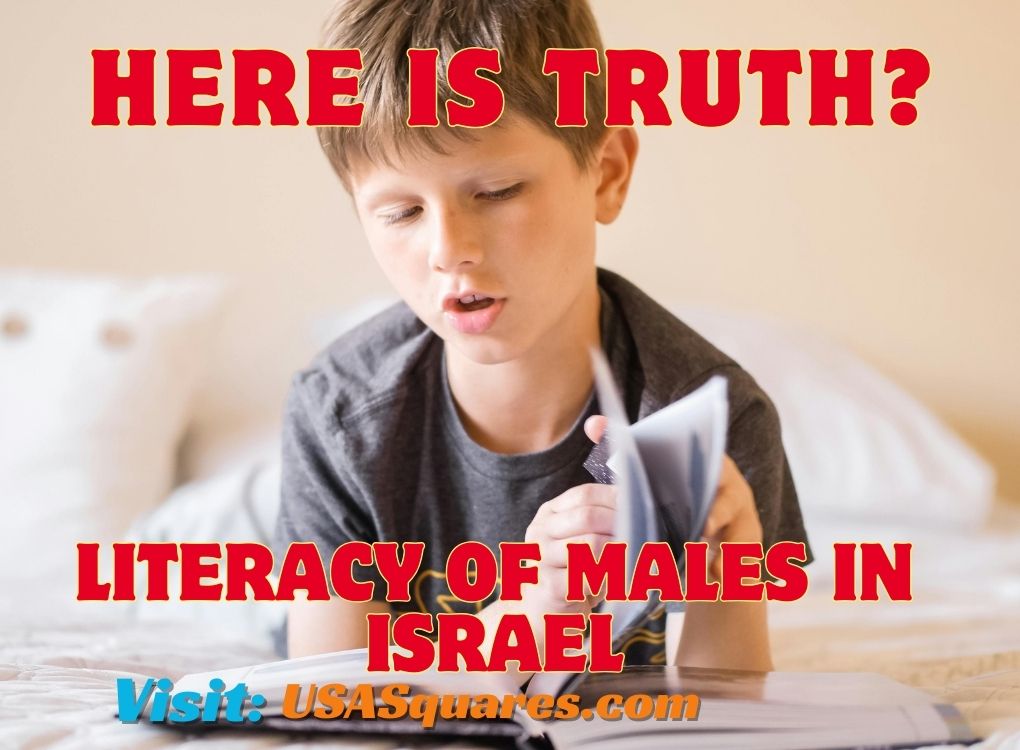
An overview of the literacy of males in Israel, showcasing impressive rates and the importance of education in the country.
The Literacy of Males in Israel: A Comprehensive Analysis
Introduction
Literacy is a fundamental skill that is crucial in personal development, social integration, and economic prosperity. In Israel, a country known for emphasizing education and innovation, literacy rates have been consistently high. This blog post delves deep into the literacy of males in israel as well as explore related topics such as israel’s literacy of males, israel total literacy, israel total literacy of males, israels total literacy rate for males, exploring historical trends, current statistics, influencing factors, israels total literacy rate for males and the broader impact on Israeli society and economy. As we embark on this comprehensive analysis, we’ll uncover the nuances of israel total literacy of males, compare it with global standards, and examine the policies and initiatives that have shaped the educational landscape. By the end of this article, you’ll have a thorough understanding of the subject, equipped with insights that shed light on the importance of literacy in shaping Israel’s past, present, and future.
- The Literacy of Males in Israel: A Comprehensive Analysis
- Introduction
- The Current State of Male Literacy in Israel
- Factors Influencing Literacy Of Males in Israel
- The Impact of Male Literacy on Israel's Society and Economy
- Challenges and Efforts to Improve Literacy Of Males in Israel
- Comparison with Neighboring Countries
- Israel's Educational System and Policies Related to Literacy
- Case Studies and Success Stories
- Future Directions and Recommendations
- Conclusion
- FAQs
The Current State of Male Literacy in Israel
Overall Literacy Rates
To understand literacy of males in israel, it’s essential to first look at the overall literacy landscape. As of the latest available data, the literacy rate in Israel for individuals aged 15 and over stands at an impressive 97.8%. This high percentage is a testament to the country’s strong educational foundation and commitment to learning. Breaking down this statistic by gender reveals that literacy of males in israel have a slightly higher literacy rate than females. The literacy rate for males is 98.7%, while for females, it’s 96.8%. This minimal gender gap indicates a relatively equitable educational environment where both males and females can access literacy-building opportunities.
Historical Context and Trends
The high literacy rates we see today in Israel result from a consistent upward trend over the decades. Historical data provides valuable insights into this progression:
- In 1983, the israel total literacy was recorded at 91.75%. This shows a significant improvement over the past four decades, with literacy rates increasing by more than six percentage points.
- For males specifically, the literacy rate for ages 15-24 in 1983 was an impressive 99.05%. This indicates that even four decades ago, Israel had achieved near-universal literacy among its young male population.
The steady improvement in literacy rates reflects Israel’s ongoing commitment to education and the effectiveness of its policies in promoting literacy across all segments of society.
Comparative Analysis
When placed in a global context, Israel’s male literacy rates are particularly noteworthy:
- Global Comparison: The global literacy rate for all people aged 15 and above is 86.3%, with males at 90.0% and females at 82.7%. israel’s literacy of males rate of 98.7% significantly surpasses these global averages, positioning the country among the world’s most literate nations.
- Regional Leadership: In the Middle East and North Africa region, Israel has consistently ranked highly in literacy rates. For instance, in 2004, Israel was ranked first for literacy rates among those aged 15-24 in this region.. This leadership position underscores the country’s educational achievements in a diverse and sometimes challenging regional context.
- Comparison with Developed Nations: While Israel’s literacy rates are commendable, they are slightly lower than other highly developed countries. Nations like Azerbaijan and Cuba boast literacy rates that approach 100%. However, Israel’s rates remain competitive with most developed countries, reflecting its status as a highly educated society.
- OECD Context: Israel’s educational attainment aligns well with OECD standards. About 88% of adults aged 25-64 in Israel have completed upper secondary education, which is above the OECD average.. This high level of educational completion contributes to the country’s strong literacy rates.

Factors Influencing Literacy Of Males in Israel
The high literacy rates among males in Israel are not accidental but result from various interplaying factors. Understanding these influences provides insight into the country’s educational success and areas for potential improvement.
1. Socioeconomic Status (SES)
Socioeconomic status plays a significant role in shaping literacy outcomes:
- Resource Access: Higher SES is often associated with better access to educational resources, including books, technology, and tutoring services. This can lead to enhanced literacy skills among males from more affluent backgrounds.
- Educational Opportunities: Families with higher SES often afford additional educational opportunities, such as private schools or extracurricular programs, which can boost literacy development.
- Parental Education: Children of parents with higher education levels tend to have better literacy skills, as educated parents are more likely to engage in literacy-promoting activities at home
2. Educational Policies and Initiatives
Israel’s educational policies have been instrumental in maintaining high literacy rates:
- Compulsory Education: Israel mandates mandatory education, ensuring that all children, including males, have access to basic schooling. This policy has been crucial in maintaining high literacy rates across different demographics.
- Early Childhood Education: Israel has implemented policies to enhance early literacy, including free education from age three to four. These early interventions lay a strong foundation for literacy development.
- Vocational Education: In vocational education and training (VET) programs, there is an emphasis on improving basic skills, including literacy, to enhance the overall skill set of the Israeli population
- Teacher Education: The evolution of teacher education in Israel from 1974 to 2024 has shaped literacy education, indicating a long-term commitment to improving literacy through enhanced teacher training
3. Cultural and Linguistic Factors
Israel’s unique cultural and linguistic landscape significantly influences literacy development:
- Multilingualism: Israel’s multilingual educational policies, analyzed over 20 years, highlight the country’s focus on language education, which is closely tied to literacy development.
- Cultural Emphasis on Education: Israeli society places a strong cultural emphasis on education, particularly within Jewish communities, which traditionally value learning and scholarship. This cultural value contributes to high literacy rates among males.
- Religious Traditions: The requirement for Jewish males to learn to read and study religious texts has historically contributed to higher literacy rates among Jewish communities.
4. Technological Advancements
Israel’s reputation as a “Start-Up Nation” and its emphasis on technology has implications for literacy:
- Digital Literacy: Technology integration in education has expanded the concept of literacy to include digital literacy skills, which are increasingly important in the modern world.
- Educational Technology: Educational technology in schools and homes provides additional tools and resources for literacy development, potentially benefiting male students who may be particularly drawn to tech-based learning.
5. Social and Political Context
The social and political environment in Israel also plays a role in shaping literacy outcomes:
- Diverse Population: Israel’s diverse population, including immigrants from various countries, presents challenges and opportunities for literacy development. Integration policies and language support programs are crucial for maintaining high literacy rates among all groups.
- Military Service: Compulsory military service for most Israeli citizens, including males, can impact educational trajectories and literacy development. The military often provides additional educational opportunities and skill development programs.
6. Gender Dynamics
While gender disparities in education are not pronounced in Israel, with women often outnumbering men in higher educationSpecific factors may still influence male literacy:
- Societal Expectations: Societal roles and expectations for males may influence their educational focus and priorities, potentially impacting their engagement with literacy-related education.
- Career Paths: The emphasis on specific career paths for males, such as those in STEM fields, may affect the attention given to literacy skills in some educational contexts.
The Impact of Male Literacy on Israel’s Society and Economy
The high literacy rates among males in Israel have far-reaching implications for the country’s social fabric and economic landscape. Understanding these impacts provides insight into the broader significance of literacy in shaping national development.
Economic Impact
1. Labor Market Participation
High literacy rates among males significantly enhance their employability and earning potential:
- Job Opportunities: Literate individuals can access a broader range of job opportunities, particularly in Israel’s knowledge-based economy.
- Income Levels: Higher literacy often correlates with higher income levels, contributing to overall economic growth.
- Immigrant Integration: For immigrants, literacy and fluency in Hebrew are crucial for economic participation, highlighting the importance of literacy programs for new arrivals.
2. Innovation and Productivity
Israel’s reputation as a hub for innovation is closely tied to its highly literate workforce:
- High-Tech Industries: The country’s education system, known for its high standards in science and technology, plays a pivotal role in driving economic success, particularly in high-tech sectors.
- Research and Development: Israel’s literate male workforce contributes significantly to its strong research and development performance, fostering innovation across various industries.
3. Economic Growth
The high literacy rate among males supports Israel’s mixed economy:
- Private Sector Contribution: A significant portion of Israel’s economic product originates from the private sector, which benefits from a highly literate workforce capable of engaging in complex economic activities
- Global Competitiveness: The literacy of the male workforce enhances Israel’s competitiveness in the worldwide market, attracting foreign investment and fostering international business relationships.
Social Impact
1. Social Mobility
Literacy serves as a key factor in promoting social mobility within Israeli society:
- Educational Attainment: Higher literacy levels are linked to better academic outcomes, facilitating upward social mobility.
- Reduced Inequality: By providing a foundation for further education and skill development, literacy helps reduce social and economic inequalities.
2. Cultural Integration
Literacy plays a crucial role in cultural integration, particularly in Israel’s diverse society:
- Language Proficiency: Reading and writing in Hebrew is essential for social integration and full participation in Israeli society, especially for immigrants and minority groups.
- Social Cohesion: A shared literacy in the national language fosters better communication and understanding among different communities, contributing to social cohesion.
3. Civic Participation
Literate males are better equipped to engage in civic life and democratic processes:
- Informed Citizenship: Literacy enables individuals to access information, understand political processes, and make informed decisions as citizens.
- Community Engagement: Literate individuals are more likely to participate in community activities and volunteer work, strengthening civil society.
4. Health Outcomes
Literacy has implications for health awareness and outcomes:
- Health Literacy: Higher literacy rates among males contribute to better health literacy, improving health outcomes and more effective use of healthcare services.
- Family Health: Literate males can positively influence family health practices, improving overall community health.
5. Intergenerational Impact
The literacy of males has a ripple effect across generations:
- Parental Influence: Literate fathers are likelier to engage in educational activities with their children, perpetuating a cycle of literacy and learning.
- Educational Aspirations: Children of literate parents often have higher academic aspirations, contributing to sustained high literacy rates across generations.
You may like to explore more interesting article on USA Squares! Unveiling the Astonishing Truth: ‘Literacy of Females in Israel’ – Top 10 Facts You Must Know

A dedicated teacher works with male and female students in Israel, fostering Israel total literacy skills and encouraging educational growthChallenges and Efforts to Improve Literacy Of Males in Israel
Despite the overall high literacy rates, Israel faces challenges in maintaining and improving literacy levels, particularly among specific demographics. Addressing these challenges is crucial for ensuring equitable access to education and keeping Israel’s competitive edge in the global knowledge economy.
Current Challenges
1. Educational Inequality
One of the significant challenges in improving Israels total literacy rate for males is the educational inequality that exists across different ethnic and socioeconomic groups. This inequality manifests in several ways, including disparities in access to quality educational resources, differences in school funding, and varying levels of parental involvement in education.
- Resource Disparities: Schools in lower-income areas may need more resources, potentially affecting the quality of literacy education.
- Cultural Differences: Different cultural backgrounds may lead to varying levels of emphasis on literacy and education.
- Language Barriers: For non-native Hebrew speakers, language barriers can pose significant challenges to achieving high literacy levels.
2. Crisis in Literacy Levels
Recent studies have shown a decline in literacy levels among Israeli students, indicating a broader crisis in the education system. This decline affects both genders but highlights systemic issues that need addressing:
- Curriculum Concerns: There may be a need to reassess and update curricula to address contemporary literacy needs better.
- Teaching Methods: Traditional teaching methods may be less effective for current generations, necessitating innovative approaches to literacy education.
3. Community-Specific Challenges
Specific communities face unique challenges in literacy, particularly in science literacy. For example, the ultra-Orthodox Jewish community may have different educational focuses that impact literacy in science and technology:
- Cultural Priorities: Some communities may prioritize religious studies over secular subjects, potentially affecting overall literacy rates.
- Integration Issues: Balancing traditional values with modern educational requirements can be challenging for some communities.
4. Digital Literacy Gap
In an increasingly digital world, the concept of literacy has expanded to include digital literacy:
- Access to Technology: Students need equal access to digital resources, potentially creating a new literacy divide.
- Adapting to New Literacy Forms: Traditional literacy skills must be complemented by digital literacy skills.
Efforts to Improve Male Literacy
To address these challenges, various initiatives and policies have been implemented:
1. Educational Policies and Initiatives
The Israeli government and educational institutions have been working on various policies aimed at reducing educational inequality and improving literacy rates.
- Targeted Programs: Initiatives focused on underprivileged communities aim to provide additional resources and support for literacy development.
- Education System Reforms: Ongoing reforms in the education system address the literacy crisis by updating curricula and teaching methods.
2. Community-Based Programs
Efforts to improve literacy through community-based programs are significant in communities with unique challenges:
- Tailored Educational Resources: Programs designed to provide culturally appropriate educational resources and support aim to improve literacy outcomes in specific communities.
- Parental Engagement: Initiatives that involve parents in their children’s literacy development have shown promise in improving overall literacy rates.
3. Focus on Language Proficiency
Recognizing the importance of language proficiency in overall literacy:
- Hebrew Appraisal Test: Initiatives such as the Hebrew appraisal test for 17-year-olds are designed to ensure that young people have a strong foundation in language proficiency
- Support for Non-Native Speakers: Programs supporting non-native Hebrew speakers in improving their language skills contribute to literacy improvement.
4. Teacher Education and Training
Enhancing the quality of literacy education through improved teacher training:
- Professional Development: Ongoing professional development programs for teachers focus on effective literacy instruction methods.
- Specialization in Literacy Education: Encouraging teachers to specialize in literacy education helps address specific literacy challenges.
5. Technology Integration
Leveraging technology to enhance literacy education:
- Digital Learning Platforms: The development and implementation of digital learning platforms provide additional resources for literacy development.
- Adaptive Learning Technologies: Using AI and machine learning to create personalized literacy learning experiences for students.
6. International Benchmarking
Learning from global best practices to improve literacy outcomes:
- OECD Comparisons: By comparing literacy rates with other OECD countries, Israel can identify gaps and areas for improvement
- Adoption of Successful Strategies: Implementing strategies that have proven successful in countries with higher literacy rates.
7. The Israel Association for Literacy and Language
This organization plays a crucial role in promoting literacy education in Israel
- Research and Advocacy: Conducting research on literacy and advocating for evidence-based literacy policies.
- Professional Support: Providing resources and support for educators involved in literacy instruction.
Comparison with Neighboring Countries
When comparing Israel’s literacy rates with its neighboring countries, it is evident that Israel stands out with higher literacy rates:
- Egypt: The literacy rate in Egypt is significantly lower, with a total literacy rate of 73.1%, and male literacy at 78.8%
- Jordan: Jordan has a relatively high literacy rate of 98.4% for males, which is comparable to Israel’s male literacy rate
- Lebanon: Lebanon’s literacy rate is 95%, with male literacy at 96.9%
- Palestine: The literacy rate in Palestine is 98%, with male literacy at 98.8%
In the Middle East, literacy rates vary significantly. Israel’s literacy rates are among the highest in the region, reflecting its developed educational infrastructure and policies. The disparity in literacy rates between Israel and some of its neighbors can be attributed to differences in educational policies, economic conditions, and social factors.
Israel’s Educational System and Policies Related to Literacy
Israel’s educational system is structured to promote high literacy rates through various policies and practices:
- Compulsory Education: Education is compulsory from age 3 to 17, which is above the OECD average of 11 years. This ensures that nearly all children have access to education, which is crucial for maintaining high literacy rates.
- Language of Instruction: The primary languages of instruction in Israel are Hebrew and Arabic, reflecting the country’s multicultural society. This bilingual approach is integral to literacy policies, as it accommodates the diverse linguistic backgrounds of Israeli students.
- Affirmative Action and Resource Allocation: The Ministry of Education has implemented affirmative action policies to reduce educational inequalities by providing additional resources to disadvantaged pupils. These policies aim to improve literacy by ensuring smaller class sizes and more instructional hours for students from lower socioeconomic backgrounds
- Integration and Multicultural Education: The Israeli education system includes integrated schools that educate Jewish and Arab students together, promoting coexistence and mutual understanding. This integration is seen as a progressive step towards reducing educational disparities and improving literacy across different cultural groups
- Technological and Scientific Emphasis: The education system places a strong emphasis on scientific and technological skills, which are essential for the country’s economic development. This focus is reflected in the curriculum and is a key component of literacy education, as it prepares students for the demands of a modern economy
- Educational Television and Lifelong Learning: Educational Television (ETV) in Israel produces and broadcasts programs for school classrooms and the general population, supporting lifelong learning and literacy development. ETV collaborates with educational professionals to develop new teaching methods and materials.

Case Studies and Success Stories
While specific case studies focusing solely on male literacy in Israel are limited in the available sources, there are examples of literacy programs that provide insights into the efforts and challenges in adult literacy education in Israel: One relevant case study is described in the document “World Perspective Case Descriptions on Educational Programs for Adults: Israel” by Eitan Israeli and Rachel Tokatli. This study compares two literacy programs for adults in Israel:
- The first program targeted illiterate individuals who immigrated to Israel in the 1950s and 1960s, primarily Oriental women who already knew Hebrew.
- The second program was aimed at recent Ethiopian immigrants, predominantly black men who did not know Hebrew and faced additional challenges.
This case study highlights the different approaches and challenges in teaching literacy to diverse groups, which can be useful in understanding literacy efforts that may include male participants. While these case studies do not exclusively focus on male literacy, they provide valuable insights into the complexities of literacy education in Israel’s diverse society. They demonstrate the need for tailored approaches that consider cultural backgrounds, language proficiency, and specific challenges faced by different immigrant groups.
Future Directions and Recommendations
To further improve Literacy of Males in Israel male literacy in Israel and address existing challenges, several recommendations can be made:
- Targeted Interventions: Develop literacy programs specifically tailored to the needs of male students, addressing cultural and societal factors that may impact their educational engagement.
- Resource Allocation: Continue efforts to reduce disparities in resource allocation between different types of schools to ensure equal educational opportunities for all students.
- Cultural Sensitivity: Design literacy initiatives that are culturally sensitive and inclusive, respecting the diverse backgrounds of Israel’s population.
- Technology Integration: Leverage technology to enhance literacy education, making it more engaging and accessible to male students.
- Parental Involvement: Encourage greater parental involvement in literacy development, recognizing the crucial role of family support in educational outcomes.
- Lifelong Learning: Promote lifelong learning initiatives to ensure that literacy skills are maintained and enhanced throughout adulthood.
- Research and Evaluation: Conduct ongoing research to evaluate the effectiveness of literacy programs and identify areas for improvement.
Conclusion
Male literacy of males in Israel presents a complex picture of achievement and ongoing challenges. While the country boasts high overall literacy rates, particularly among males, there are still disparities and areas for improvement. The cultural emphasis on education, compulsory schooling policies, and various literacy initiatives have significantly contributed to Israel’s literacy of males, helping maintain high levels of educational attainment.
However, challenges remain, particularly in addressing socioeconomic and ethnic disparities and cultural factors that may impact male educational engagement. The impact of Israel total literacy on employment, social mobility, and overall quality of life underscores the importance of continued efforts to improve and maintain Israels total literacy of males.
As Israel continues to evolve as a multicultural society with a strong emphasis on technology and innovation, the importance of literacy cannot be overstated. By addressing existing challenges and building on successful initiatives, Israel can further strengthen its position as a leader in education and literacy, ensuring that all its citizens, including males, have the skills necessary to thrive in the modern world. This commitment to improving Israels total literacy rate for males is crucial for fostering a more equitable and prosperous society.
FAQs
- What is the current male literacy rate in Israel? The current male literacy rate in Israel is approximately 98.7%, which is significantly higher than the global average
- How does Israel’s literacy rate compare to neighboring countries? Israel’s literacy rate is among the highest in the Middle East region, surpassing countries like Egypt and Lebanon, and comparable to Jordan and Palestine
- What are the main challenges affecting male literacy in Israel? Main challenges include socioeconomic disparities, ethnic differences, educational underachievement among some male groups, and cultural factors that may impact educational priorities
- How does literacy impact employment in Israel? Higher literacy levels are strongly associated with better job opportunities and higher income levels in Israel, contributing to economic stability and growth
- What initiatives are in place to improve literacy in Israel? Several initiatives exist, including the Israel Association for Literacy and Language, Family Literacy Initiative, and various programs targeting children and adults to improve reading skills and overall literacy
- How does Israel’s educational system support literacy development? Israel’s educational system supports literacy through compulsory education from age 3 to 17, bilingual instruction, affirmative action policies, and a strong emphasis on scientific and technological skills
- What role does technology play in literacy education in Israel? Technology plays a significant role, with Educational Television (ETV) producing and broadcasting educational programs, and an increasing emphasis on integrating technology into the curriculum to enhance literacy skills
- How has male literacy in Israel changed historically? Male literacy in Israel has significantly improved over the centuries, from less than 3% in ancient times to the current high rate of 98.7%, reflecting the country’s emphasis on education and cultural values
- What is the impact of literacy on social mobility in Israel? Literacy is a powerful enabler of social mobility in Israel, providing individuals from lower socioeconomic backgrounds with tools to improve their social and economic standing
- Are there any specific programs targeting male literacy in Israel? While specific programs exclusively targeting male literacy are not detailed in the available sources, various literacy initiatives in Israel benefit male participants as part of broader educational efforts.
Read more captivating content and uncover fascinating insights on USA Squares!




1 thought on “Top 5 Facts: Do You Know the Literacy of Males in Israel? Unlock the truth behind the numbers and know everything about male literacy in Israel!”